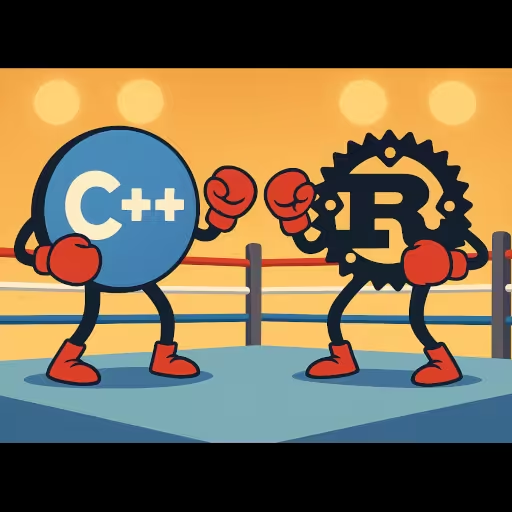What Does L3 Cache Do for C++ Performance
If you write C++ and care about speed, you need a mental model of how data moves between registers, cache, and RAM. This article explains the parts you can’t control directly—and the parts you can influence with simple code and build choices. If you’re brushing up on lifetimes and allocation strategy, pair this with the companion piece: Dynamic Memory Allocation in C++.
What Is CPU Memory for C++ Programs
Think of your program’s data moving through a funnel:
- Registers (inside the core): tiny and blazing fast; the compiler puts hot values here while executing instructions.
- L1/L2/L3 caches (on the chip): small to larger staging areas that keep recently used data close, to avoid slow trips to RAM.
- Main RAM: big and flexible, but far slower than caches. Your stack and heap both live here.
- Virtual memory: the OS abstraction that maps your addresses to physical RAM (and, if needed, to disk). Hitting disk is the slow path.
Important reality check: You cannot tell the CPU, “put this vector in L3” or “keep this value in a register.” The compiler chooses registers, the hardware manages caches, and the OS maps memory to RAM. Your job is to write code that’s easy for them to optimize.
What Is L3 Cache
L3 is the largest on-chip cache (often shared by multiple cores). It’s a safety net: when data falls out of L1/L2, L3 gives you one more chance to hit a fast store before paying RAM latency. So, what does L3 cache do in practice? It cuts average memory latency by serving recently used cache lines from on-chip memory instead of DRAM.
What Is L3 Cache Used For?
The L3 cache, also called the “last level cache,” sits between the lightning-fast registers and L1/L2 caches, and the slower main RAM. It’s a communal area that all CPU cores tap into and plays a few key roles:
-
Speed Buffer It stores recently used instructions or data that didn’t fit into L1 or L2. This avoids those long trips to RAM, which are orders of magnitude slower. ([Lenovo][1])
-
Core Coordination Since L3 is shared, it acts as a coordination hub—helping cores communicate without repeatedly pulling from RAM. ([Redis][2])
-
Multicore Efficiency In multitasking or heavily threaded workloads, a larger L3 can reduce cache misses and keep performance smoother. ([Lenovo][1], [Digital Trends][3])
-
Energy Savings Serving data from L3 uses less energy than fetching from RAM. That can add up over time. ([Lenovo][1])
Is L3 Cache Important for Gaming?
Often, yes. Big worlds, AI, physics, and streaming content push past L1 and L2 caches. A generous L3 reduces stalls between frames—if your data layout and access patterns are friendly to the cache.
Think of an open-world game like Elden Ring or Cyberpunk 2077: the CPU constantly streams in new terrain, runs AI for dozens of characters, and checks physics collisions. These tasks generate a huge working set that won’t all fit into the tiny L1 and L2 caches. With a larger L3, more of that active data stays “on chip,” meaning the CPU can respond quickly instead of stalling while waiting on RAM. The effect is subtle—often not higher average frame rates, but fewer frame-time spikes and less stutter.
That’s why chips like AMD’s X3D processors (e.g., the Ryzen 7 9800X3D) with 3D-stacked L3 cache often shine in gaming benchmarks. They don’t necessarily clock higher, but they feed the cores more consistently, smoothing out gameplay in titles that juggle massive datasets.
👉 So while L3 cache isn’t a silver bullet, in CPU-bound games it can make the difference between smooth and slightly choppy.
Stack and Heap Memory in C++
Both the stack and heap are carved out of RAM, but they behave very differently in C++.
Stack (automatic storage):
The stack is managed automatically by the compiler. Every time a function is called, its local variables are pushed onto the stack. When the function returns, those variables are popped off.
- Lifetime: Bound to the scope. Variables disappear automatically when the function exits.
- Performance: Extremely fast because allocation is just moving the stack pointer.
- Limitations: Fixed size (a few MB by default). You cannot hold large arrays here without risking a stack overflow.
void foo() {
int x = 42; // stack
std::array<int, 100> a; // fixed-size buffer, stack
} // memory is reclaimed here automaticallyHeap (dynamic storage):
The heap is managed manually (or through abstractions like smart pointers). You request memory explicitly at runtime, and it remains allocated until you free it or its owner goes out of scope.
- Lifetime: Flexible — objects can outlive the function they were created in.
- Performance: Slower than the stack because the runtime allocator must find a free block of memory.
- Safety: Risk of leaks, double frees, and dangling pointers if you use raw
new/delete. That’s why modern C++ uses RAII tools likestd::vector,std::string, and smart pointers.
auto ptr = std::make_unique<int>(99); // heap allocation with ownership
std::vector<int> nums(1000, 0); // heap-backed dynamic arrayThe Difference Between Stack and Heap Memory in C++
- Management: The stack is compiler-managed and automatic; the heap is application-managed (directly or via containers).
- Lifetime: Stack memory vanishes with scope; heap memory lives until explicitly freed or an RAII wrapper releases it.
- Performance: Stack allocation is almost free; heap allocation costs more and can fragment over time.
- Safety: Stack avoids leaks by design; heap requires discipline (or smart abstractions) to stay safe.
- Capacity: Stack is small but fast; heap is large but slower.
👉 Rule of thumb: Use the stack for small, short-lived objects, and the heap when you need flexible size or longer lifetimes.
How You Can Influence Caches and Registers From High-Level C++
You can’t place data into L3 or pin values in registers, but you can make those layers work for you:
-
Keep data contiguous. Prefer
std::vectoror structure-of-arrays (SoA) when you iterate field-wise. Contiguous memory boosts cache hits and helps auto-vectorization. -
Access data predictably. Process in linear scans or small tiles instead of random jumps. Hardware prefetchers guess better when your next access is obvious.
-
Reserve and batch. Call
reserve()on vectors to avoid frequent reallocations; batch allocations instead of per-elementnew. -
Use prefetch hints where it helps. For long, forward scans, a small prefetch distance can hide latency.
-
Align to cache lines for hot data.
alignas(64)can reduce false sharing between threads. -
Build for your CPU. Turn on optimization and the right target ISA (e.g.,
-O3 -march=nativewith Clang/GCC). The compiler then emits instructions that your machine executes efficiently. -
NUMA awareness (servers/workstations). Keep threads close to their data (Linux’s
numactlor APIs). You’re choosing which RAM bank, not which cache.
You don’t have to read a 500-page microarchitecture manual to benefit. Intrinsics and good containers give you the 80/20.
x86 Prefetch Instructions in C++
A gentle, optional hint to stage future data:
#include <immintrin.h>
#include <cstddef>
void sum_prefetch(const float* data, std::size_t n, std::size_t pf_dist, float& out) {
float acc = 0.0f;
for (std::size_t i = 0; i < n; ++i) {
if (i + pf_dist < n) {
_mm_prefetch(reinterpret_cast<const char*>(data + i + pf_dist), _MM_HINT_T0);
}
acc += data[i];
}
out = acc;
}- Start with a small
pf_dist(e.g., 64—256 bytes ahead). Measure; don’t guess. - These are hints, not guarantees. If your access is already linear, hardware prefetchers may be enough.
C++ Instruction Set Basics
SIMD intrinsics (SSE/AVX/NEON on ARM) are thin wrappers over the CPU’s vector instructions. They don’t place data into caches, but they do more math per cache line, which raises effective throughput. Let the compiler auto-vectorize, then use intrinsics for the final few percent if a hot loop still dominates.
Stack Overflow C++ Example
Deep or unbounded recursion can blow the stack:
int recurse_forever(int x) { return recurse_forever(x + 1); } // no base case → crashPrefer an explicit loop or a small manual stack for deeply nested work.
How Does L3 Cache Affect Performance?
L3 cache acts like a high-speed waiting room for data that doesn’t fit in the smaller L1 or L2 caches. When your code requests data, the CPU checks caches in order: L1, then L2, then L3, before falling back to main RAM. Because RAM is much slower, having a larger or more efficient L3 dramatically reduces the number of costly memory stalls.
In practice, this means:
- Higher hit rates = smoother performance. When L3 has room to hold more of your working set, fewer trips go out to RAM. This keeps pipelines full and avoids stuttering in workloads like gaming, simulations, or financial modeling.
- Better multicore efficiency. Since L3 is often shared, it allows multiple cores to access common data quickly without each hammering RAM.
- Diminishing returns for small workloads. If your program’s data already fits in L1/L2, the size of L3 matters less. The benefits show up most with large datasets and heavily threaded applications.
👉 In short: L3 doesn’t make every program faster, but when your workload spills past L1/L2, it can be the difference between smooth throughput and constant stalls.
L3 Dynamic Memory Allocation in C++: Solutions You Can Actually Use
- Use contiguous containers and call
reserve()before filling. - Process arrays in linear or tiled passes.
- Try prefetch on big, forward scans; remove it if it doesn’t help.
- Align hot structs or arrays with
alignas(64)when false sharing shows up in profiles. - Build with
-O3 -march=native(or explicit target like-march=znver4, etc.). - Keep threads and data co-located on NUMA hardware.
// Minimal, cache-friendly pattern
std::vector<float> a;
a.reserve(N);
// fill a ...
double sum = 0;
for (size_t i = 0; i < a.size(); ++i) {
sum += a[i]; // sequential, predictable access
}Conclusion
- You don’t control registers or L3; you shape access so the compiler and CPU do the right thing.
- L3 reduces average latency; you feel the win when data is contiguous and access is predictable.
- Use prefetching, alignment, and NUMA pinning when profiles say memory is the bottleneck—not by default.
// If a loop dominates time, try: contiguous data + reserve + tuned -O flagsWant the nuts and bolts of lifetimes and allocation (stack vs heap, RAII, containers)? Read the companion guide: Dynamic Memory Allocation in C++.











